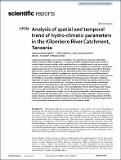Analysis of spatial and temporal trend of hydro‑climatic parameters in the Kilombero River Catchment, Tanzania

View/
Date
2023-05-15Author
Sigalla, Onesmo
Valimba, Patrick
Selemani, Juma
Kashaigili, Japhet
Tumbo, Madaka
Metadata
Show full item recordAbstract
Inadequate knowledge on actual water availability, have raised social-economic conficts that
necessitate proper water management. This requires a better understanding of spatial–temporal
trends of hydro-climatic variables as the main contributor to available water for use by sectors of
economy. The study has analysed the trend of hydro-climatic variables viz. precipitation, temperature,
evapotranspiration and river discharge. One downstream river gauge station was used for discharge
data whereas a total of 9 daily observed and 29 grided satellite stations were used for climate data.
Climate Hazards Group InfraRed Precipitation was used for precipitation data and Observational Reanalysis Hybrid was used for Temperature data. Mann–Kendall Statistical test, Sen’s slope estimator
and ArcMap Inverse Distance Weighted Interpolation functionality were employed for temporal,
magnitude and spatial trend analysis respectively. Results confrmed that, spatially, there are three
main climatic zones in the study area viz. Udzungwa escarpment, Kilombero valley and Mahenge
escarpment. On temporal analysis, with exception of the declining potential evapotranspiration
trend, all other variables are on increase. This is with catchment rates of 2.08 mm/year, 0.05 °C/year,
0.02 °C/year, 498.6 m3
/s/year and − 2.27 mm/year for precipitation, Tmax, Tmin, river discharge and
PET respectively. Furthermore, rainfalls start late by a month (November) while temperatures picks
earlier by September and October for Tmax and Tmin respectively. Water availability matches farming
season. However, it is recommended to improve water resources management practices to limit fow
impairment as expansions in sectors of economy are expected. Furthermore, landuse change analysis
is recommended to ascertain actual trend and hence future water uptake.
URI
https://doi.org/10.1038/s41598-023-35105-8https://dspace.nm-aist.ac.tz/handle/20.500.12479/1892
